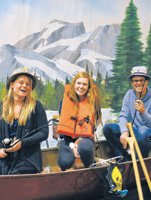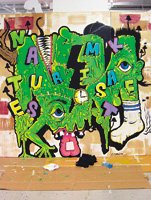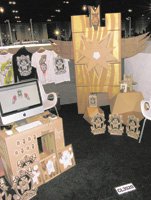Thinking Outside the Trade Show Box
For Todd Masters, creating a big impact in a small trade show booth often takes nothing more than a cheap stage prop.
At the Class trade show, Masters has brought in everything from a life-size burro, which he rented for $100 from a prop warehouse, to an old canoe that he purchased from Craigslist for $100 to attract attention for his Newport Beach, Calif.–based label, Toddland.
Buyers and show attendees often are drawn in by the admittedly silly stage props, and a Toddland worker is always on hand to take their picture by the prop. Soon the buyers are talking to the Toddland team about the label’s designs, Masters said.
“When you’ve got unlimited creativity with limited funds, it makes you think a little differently than the brands that can just write a check,” he said of his trade show visual-display strategy. “It has kind of become our signature at shows, and everybody wonders what we are going to be up to next.”
Many fashion labels find themselves in the position of having to grab buyers’ attention in trade show environments where they have little space and must increasingly follow rules curtailing big displays.
Some of fashion’s most prominent trade events—including Project, Agenda and Class—maintain strict guidelines keeping booths small, signage plain and noise level to a minimum.
“We try to control that as much as possible,” said Jason Bates, founder of Class, which takes place at the Santa Monica Civic Auditorium in Santa Monica, Calif. “Once you open the floodgates [for big, extravagant booths], then it becomes chaos.”
Toddland gets a pass because the label’s logo is not on the display, the displays are unique and the fashion label adds a service to the show, according to Bates. The Toddlanders provide a photobooth-like service where they take photos of buyers at their booth.
At most trade shows, vendors are supplied with prefabricated booths. The prefab booths can be stylish, with walls made out of brushed aluminum, for example. Agenda co-founder and President Aaron Levant said he is strict about keeping booth equalitarianism and banning models and loud music. They stop buyers and vendors from concentrating on business and making deals, Levant said.
However, if a vendor adds something unique to a booth, Agenda management will make an exception, Levant said. “You can still make it cool within the confines of a prefabricated booth,” he said.
One of those Agenda vendors is Mason Brown. He debuted his Long Beach, Calif.–based accessories, toy and fashion line, Church of Clocky, at Agenda in August 2010. In a space smaller than 10 by 10, Brown made it unique with cardboard figures of the line’s main character, Clocky. “It was all cardboard, hot glue and paint,” Brown said. Although it did not cost much to build, it took him months to make the different Clocky figures.
Other fashion labels find novel ways to make small booths unique. Monrovia, Calif.–based label Nature’s Mistake exhibits at the Focus trade show at the California Market Center as well as at the Thread shows in San Diego and San Francisco.
Nature’s Mistake founder Matt Geiger said the first step for decorating his booth is hanging his newest T-shirts on the walls of his 10-by-10 space. Sometimes he’ll post a Las Vegas–style sign surrounded by bulbs on the booth. But the star attraction is a portable screen-printing press at the edge of the booth. He gives out free T-shirts with Nature’s Mistake designs on it. “It always seems to attract a crowd of people,” he said.
Buying a booth is still a strong option, according to Jesus Gomez, sales director of Ontario, Calif.–based Trade Show Display Depot. For decorating 10-by-10 booths, Gomez recommended dressing the booth in bright colors and placing short, simple messages on banners. “Lighting is a big factor,” he said. “When your booth has bright lights, it stands out. It makes a huge difference.”
























